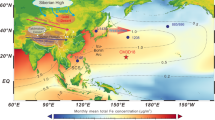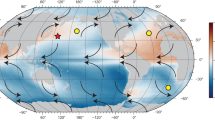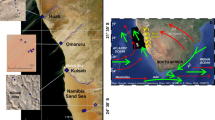Abstract
THE2,083-m Vostok ice core recovered by the Soviet Antarctic expeditions has provided much information of climatic and environmental interest, for a period covering a full glacial–inter-glacial cycle1–6. Here we present and discuss the dust record obtained down to 2,202 m, the final depth to which this core was extended in 1986. First, we document the fact that major changes in aeolian deposits, as recorded in the Vostok core, appear to be of global significance and confirm the existence of a link between high-latitude aeolian deposits and the Earth's orbital parameters7,8. Second, we propose atmospheric dust as a strati-graphic marker to compare timing with other records of palaeocli-mate, and use the magnetic-susceptibility profile measured along the RC11-120 Indian Ocean core9 for this purpose, assuming that major dust events correspond to common aeolian inputs. This approach indicates that the Vostok and marine records were roughly in phase at the previous glacial–interglacial transition.
This is a preview of subscription content, access via your institution
Access options
Subscribe to this journal
Receive 51 print issues and online access
$199.00 per year
only $3.90 per issue
Buy this article
- Purchase on Springer Link
- Instant access to full article PDF
Prices may be subject to local taxes which are calculated during checkout
Similar content being viewed by others
References
Lorius, C. et al. Nature 316, 591–596 (1985).
De Angelis, M., Barkov, N. I. & Petrov, V. N. Nature 325, 318–321 (1987).
Jouzel, J. et al. Nature 329, 403–408 (1987).
Barnola, J. M., Raynaud, D., Korotkevitch, Y. S. & Lorius, C. Nature 329, 408–414 (1987).
Legrand, M., Lorius, C., Barkov, N. I. & Petrov, V. N. Atmos. Emir. 22, 317–331 (1988).
Raynaud, D., Chappellaz, J., Barnola, J. M., Korotkevitch, Y. S. & Lorius, C. Nature 333, 655–657 (1988).
Legrand, M., Delmas, R. J. & Charlson, R. J. Nature 334, 418–420 (1988).
Beget, J. E. & Hawkins, O. B. Nature 337, 151–153 (1989).
Kent, D. V. Nature 299, 538–539 (1982).
Mounier, L. thesis, Université Scientifique Technologique et Médicale de Grénoble (1988).
De Angelis, M. et al. Atmos. Chem. 1, 215–239 (1984).
Lorius, C., Raisbeck G., Jouzel, J. & Raynaud D. in The Environmental Record in Glaciers and Ice Sheets (eds Oeschger, H & Langway, C. C. Jr) 343–361 (Wiley, Chichester, 1989).
Briat, M., Royer, A., Petit, J. R. & Lorius, C. Ann. Glaciol. 3, 27–31 (1982).
Gaudichet, A., Petit, J. R., Lefevre, R. & Lorius, C. Tellus B38, 250–261 (1986).
Gaudichet, A. et al. Geophys. Res. Lett. 15, 1471–1474 (1988).
Petit, J. R., Briat, M. & Royer, A. Nature 293, 391–394 (1981).
Lorius, C., Raynaud, D., Petit, J. R., Jouzel, J. & Merlivat, L. Ann. Glaciol. 5, 88–95 (1984).
Guiot, J., Pons A., De Beaulieu, J. L. & Reille, M. Nature 338, 309–313 (1989).
Thomson, D. J. Proc. IEEE 70, 1055–1096 (1982).
Yiou, F. et al. in Interaction of the Global Carbon Cycle and Climate System, Electric Power Res. Inst. Rep. (ed. Keir P.) (Kluwer, in the press).
Berger, A. I. J. Atmos. Sci. 35, 2362–2367 (1978).
Thompson, L. G. & Mosley-Thompson, E. Science 212, 812–815 (1981).
Hammer, C. et al. Geophys. Monogr. 33, 90–94 (1985).
Heusser, C. J. Quat. Res. 16, 293–321 (1981).
Bowler, J. M. Earth Sci. Rev. 12, 279–310 (1976).
Kukla, G. Quat. Sci. Rev. 6, 191–219 (1987).
Robinson, S. G. Phys. Earth planet. Inter. 42, 22–47 (1986).
Hovan, S. A., Rea, D. K., Pisias, N. G. & Shackleton, N. J. Nature 340, 296–298 (1989).
Martinson, D. G. et al. Quat. Res. 27, 477–482 (1987).
Kolla, V., Henderson, L. & Biscaye, P. Deep Sea Res. 23, 949–961 (1976).
Kolla, V. & Biscaye, P. J. sedim. Pedology. 47, 642–649 (1977).
Winograd, I. J., Barney, J., Zabo, B. J., Coplin, T. B. & Riggs, A. C. Science 242, 1275–1280 (1988).
Author information
Authors and Affiliations
Rights and permissions
About this article
Cite this article
Petit, J., Mourner, L., Jouzel, J. et al. Palaeoclimatological and chronological implications of the Vostok core dust record. Nature 343, 56–58 (1990). https://doi.org/10.1038/343056a0
Received:
Accepted:
Issue Date:
DOI: https://doi.org/10.1038/343056a0
This article is cited by
-
Antarctic evidence for an abrupt northward shift of the Southern Hemisphere westerlies at 32 ka BP
Nature Communications (2023)
-
Two-tiered reconstruction of Late Pleistocene to Holocene changes in the freezing level height in the largest glacierized areas of the Colombian Andes
Journal of Mountain Science (2022)
-
Response of Sandy Lake in Schirmacher Oasis, East Antarctica to the glacial-interglacial climate shift
Journal of Paleolimnology (2017)
-
Radiocarbon evidence for enhanced respired carbon storage in the Atlantic at the Last Glacial Maximum
Nature Communications (2016)
-
Climatic responses to the shortwave and longwave direct radiative effects of sea salt aerosol in present day and the last glacial maximum
Climate Dynamics (2012)
Comments
By submitting a comment you agree to abide by our Terms and Community Guidelines. If you find something abusive or that does not comply with our terms or guidelines please flag it as inappropriate.



